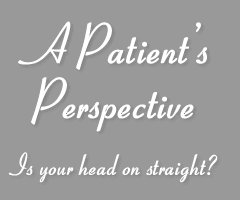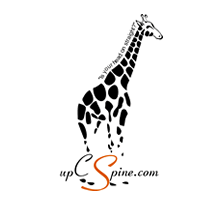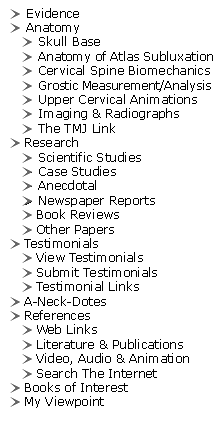| SKULL BASE |
| In
order to understand the types of problems and symptoms one
might experience as a result of an atlas to skull subluxation
it's necessary to have a close up look at the junction
between the skull and the first cervical vertebra or atlas
[craniocervical junction]. READ
MORE... |
|
| ANATOMY OF ATLAS SUBLUXATION |
| The
atlas subluxation is so common yet so easily missed
by mainstream medical practitioners. This problem is
not very difficult to detect, in fact my 10-year-old
daughter has become quite adept at picking out people
walking down the street who exhibit the hallmarks of
this upper cervical subluxation. READ
MORE... |
|
|
| CERVICAL SPINE
BIOMECHANICS |
| Understanding
of cervical spine biomechanics is important in understanding
the mechanism of any injury to the upper cervical spine. READ
MORE... |
|
| GROSTIC MEASUREMENT |
| The
Grostic Procedure had its origins in the Palmer Specific Upper
Cervical technique. It was one of several techniques that
developed as a result of efforts to standardize chiropractic
procedures and methods. READ
MORE... |
|
| UPPER CERVICAL
ANIMATIONS |
| A series
of animations and morphs, which have been created to explain
aspects of upper cervical chiropractic and its affect on different
conditions.READ
MORE... |
|
| IMAGING &
RADIOGRAPHS |
| This
section is to help you understand the different imaging and
diagnostic options available to many practitioners today,
and help you with some idea about what you need to look for
when understanding your own images, scans and radiographs.
There are many technologies available today which can assist
chiropractors in locating and correcting the source of your
discomfort. The scientific validity of these technologies
is not in question. READ
MORE... |
|
| THE TMJ LINK |
| TMJ
stands for temporomandibular joint and according to the AAOMS
"is a small joint in front of the ear where the skull
and the lower jaw meet. This joint allows the lower jaw (mandible)
to move and function, and is the most constantly used joint
in the body." READ MORE... |
|





